The Genus Psenulus Kohl, 1897 (Hymenoptera: Crabronidae) in China, with Two New Species and Two New Country Records †
Simple Summary
Abstract
1. Introduction
2. Materials and Methods
3. Results
3.1. Systematics
| 1. Interantennal carina prominent, dorsally sharp……………………………………………2 |
| - Interantennal carina prominent, dorsally broadened and concave………………………...8 |
| 2. Thorax black…………………………P. ephippius Taylor, Barthélémy, Chi, and Guénard |
| - Thorax black with yellow marks or almost entirely yellow…………………………………3 |
| 3. Thorax almost entirely yellow…………P. pallens Taylor, Barthélémy, Chi, and Guénard |
| - Thorax black with yellow marks……………………………………………………………....4 |
| 4. Petiole black; gaster black, segments II with reddish-brown marks to various degrees; transverse carina below antennae absent…………………P. carinifrons rohweri van Lith |
| - Petiole yellow to red at base, dark-brown distally; gaster yellow to red; transverse carina below antennae distinct or absent……………………………………………………………5 |
| 5. Transverse carina below antennae absent; pygidial plate elongate-triangular with sharp lateral carinae…………………………………………………………P. continentis van Lith |
| - Transverse carina below antennae conspicuously long; pygidial plate short and narrow with distinct or indistinct lateral carinae…………………………………………………….6 |
| 6. Free margin of clypeus with two blunt triangular teeth medially, emargination between teeth blunt triangle; lateral mark of mesoscutum along tegula short and narrowly band- shaped, not reaching anterior margin of mesoscutum…P. maculatus maculatus van Lith |
| - Free margin of clypeus slightly or conspicuously prominent and truncate medially; lateral mark of mesoscutum along tegula reaching anterior margin of mesoscutum…7 |
| 7. Free margin of clypeus with rectangular prominence medially, deeply emarginate on either side of prominence; pygidial plate with distinct lateral carinae, parallel on apical half; median marks of mesoscutum band-shaped, as long as mesoscutum, ending in one large, transverse mark along mesoscutum posterior margin..P. xanthonotus van Lith |
| - Free margin of clypeus with slightly truncate prominence medially; pygidial plate with indistinct lateral carinae; median marks of mesoscutum long and narrowly stripe-shaped, reaching anterior margin of mesoscutum and not extending to posterior margin………………………………………...……………P. ornatus pempuchiensis Tsuneki |
| 8. Gaster yellow to red………………………………………………………………………….9 |
| - Gaster black or mostly black…………………………………………………………………14 |
| 9. Free margin of clypeus quadridentate medially………………………………………….10 |
| - Free margin of clypeus bidentate or truncate medially……………………………………11 |
| 10. Free margin of clypeus quadridentate medially, small, of same size and at same horizontal level; pygidial plate narrowly grooved, lateral carinae almost parallel………………………………………………...……………...P. dentideus Ma and Li |
| - Free margin of clypeus bidentate medially, deeply emarginate on either side of teeth and with small tooth on outer side of emargination; pygidial plate elongate-triangular with conspicuous lateral carinae………………………………………P. quadridentalus van Lith |
| 11. Body length < 9 mm, medium-sized; propodeal enclosure incomplete or short; dorsal surface of petiole without longitudinal carina medially…………………………………12 |
| - Body length > 10 mm, large-sized; propodeal enclosure complete and long; dorsal surface of petiole with longitudinal carina medially………………………………………………13 |
| 12. Petiole black; transverse carina below antennae absent; propodeal enclosure narrowly triangular, with median longitudinal carina; base of hind tibia with longitudinal groove……………………………………P. gibbus Taylor, Barthélémy, Chi, and Guénard |
| - Petiole reddish-yellow; transverse carina below antennae conspicuously long, arched in frontal view; propodeal enclosure short, triangular, without median longitudinal carina; hind tibia without longitudinal groove…………………………P. parvidentatus van Lith |
| 13. Petiole dark reddish-brown, almost black; transverse carina below antennae absent; propodeal enclosure well-defined posteriorly…………………P. clypeoconvexus sp. nov. |
| - Petiole reddish-yellow; transverse carina below antennae conspicuously long, almost reaching outer side of antennal sclerites; propodeal enclosure ill-defined posteriorly……………………………………………………………P. carinitibialis sp. nov. |
| 14. Transverse carina below antennae absent; pygidial plate absent…P. suifuensis van Lith |
| - Transverse carina below antennae conspicuously long; pygidial plate with distinct or indistinct lateral carinae……………………………………………………………………15 |
| 15. Petiole long; propodeal enclosure ill-defined posteriorly; propodeum behind enclosure smooth and shiny…………………….………………………………………………………16 |
| - Petiole short; propodeal enclosure well-defined or indistinctly defined posteriorly; propodeum behind enclosure rugose………………………………………………………17 |
| 16. Gaster black with some segments red; transverse carina below antennae conspicuously long, almost reaching outer side of antennal sclerites; dorsal surface of petiole with broad longitudinal excavation, lateral surface somewhat carinated…P. bicinctus Turner |
| - Gaster black, lateral surface somewhat brown; transverse carina below antennae short, reversed V-shaped; dorsal surface of petiole with deep longitudinal groove, lateral surface with sharp carina at base…………………………………………P. orinus van Lith |
| 17. Dorsal surface of petiole with broad longitudinal depression, ventral surface rounded; pygidial plate broadly triangular………………………………………………….……….18 |
| - Dorsal surface of petiole with longitudinal groove medially, ventral surface carinate; pygidial plate long and narrowly groove-shaped………………………………………19 |
| 18. Free margin of clypeus with deep emargination medially, subtriangular; pygidial plate with indistinct lateral carinae; propodeum behind enclosure with fine, oblique longitudinal striation………………………………………………………P. pallipes (Panzer) |
| - Free margin of clypeus with relatively shallow, arcuate emargination medially; pygidial plate with conspicuously sharp lateral carinae; propodeum behind enclosure coarsely carinate and rugose……………………………………………………...P. formosicola Strand |
| 19. Mandible tridentate, middle tooth broad and blunt; central part of clypeal margin with shallow depression; pygidial plate narrowly grooved…………………P. lubricus (Pérez) |
| - Mandible tridentate, middle tooth narrow and sharp; central part of clypeal margin deeply impressed; pygidial plate elongated and linear………………P. yingfeng Tsuneki |
| 1. Antennae without tyloids……………………………………………………………………2 |
| - Antennae with tyloids………………………………………………………………………...11 |
| 2. Thorax black…………………………………………………………………………………...3 |
| - Thorax yellow or thorax black with yellow marks…………………………………………6 |
| 3. Gaster black; petiole short, subquadrate, dorsal surface of petiole with longitudinal groove medially…………………………………………………………P. formosicola Strand |
| - Gaster yellow to red; petiole short, cylindrical, dorsal surface smoooth and shiny…….4 |
| 4. Dorsal surface of propodeum smooth and shiny, rest of propodeum densely and coarsely reticulate; interantennal carina sharply elevate……………………………………P. ephippius Taylor, Barthélémy, Chi, and Guénard |
| - Apex of posterior surface and lateral surface of propodeum coarsely reticulate; interantennal carina slightly broadened but not excavate…………………………………5 |
| 5. Propodeal enclosure well-defined posteriorly, propodeum behind enclosure shiny and rugose; free margin of clypeus with semicircular emargination medially…………………………………………………………P. clypeoconvexus sp. nov. |
| - Propodeal enclosure ill-defined posteriorly, propodeum behind enclosure smooth and shiny; free margin of clypeus with triangular emargination medially……………………………………………………………P. carinitibialis sp. nov. |
| 6. Mesothorax almost entirely yellow; free margin of clypeus with two sharp triangular teeth medially, emargination between teeth sharply triangular………………………………P. pallens Taylor, Barthélémy, Chi, and Guénard |
| - Mesothorax black with yellow marks; free margin of clypeus slightly convex and with two inconspicuous teeth medially or distinctly prominent and truncate medially……7 |
| 7. Petiole black; gaster black; free margin of clypeus with distinctly truncate prominence medially………………………………………………………P. carinifrons rohweri van Lith |
| - Petiole yellow to red, except black at apex; gaster yellow to red; free margin of clypeus slightly convex, with two faint teeth medially……………………………………………...8 |
| 8. Propodeum yellow except enclosure and median longitudinal groove black; mesoscutum with large yellow marks, broadly band-shaped……P. continentis van Lith |
| - Propodeum black with yellow marks on posterior surface; mesoscutum with small yellow marks, band-shaped or stripe-shaped or patchy…………………………………9 |
| 9. Lateral mark of mesoscutum along tegula short and narrowly band-shaped, median marks of mesoscutum at apex triangularly patchy…………………P. hoozanius van Lith |
| - Mesoscutum along tegula with or without mark, median marks long and narrowly stripe-shaped, broadened at apex. …………………………………………………………10 |
| 10. Mesoscutum along tegula without mark, median marks beginning at prescutal sutures and not reaching anterior margin of mesoscutum; free margin of clypeus slightly convex, almost truncate…………………………………………P. ornatus ornatus (Ritsema) |
| - Mesoscutum along tegula with yellow mark, median marks reaching anterior margin of mesoscutum; free margin of clypeus distinctly prominent……………………………………………………P. ornatus pempuchiensis Tsuneki |
| 11. Gaster yellow to red………………………………………………………………………...12 |
| - Gaster black or mostly black…………………………………………………………………15 |
| 12. Thorax black with yellow marks; interantennal carina sharp…………………………………………………………P. maculatus maculatus van Lith |
| - Thorax black; interantennal carina broadened dorsally, concave or not…………………13 |
| 13. Petiole black; interantennal carina broadened dorsally but not concave; mesopleural suture smooth, not foveolate……………P. gibbus Taylor, Barthélémy, Chi, and Guénard |
| - Petiole yellow to red; interantennal carina broadened dorsally and concave; mesopleural suture foveolate………………………………………………………………………………14 |
| 14. Gaster yellow; flagellomeres narrowly rectangular, with short carina-like tyloids; first recurrent vein received by first submarginal cell………………P. quadridentalus van Lith |
| - Gaster red; flagellomeres stubby and rounded, with elongated oval tyloids; first recurrent vein received by first submarginal cell, second submarginal cell, or interstice between first and second submarginal cells………………………P. dentideus Ma and Li |
| 15. Transverse carina below antennae absent or inconspicuous………P. suifuensis van Lith |
| - Transverse carina below antennae conspicuously long……………………………………16 |
| 16. Flagellomeres IV-VIII with linear tyloids; propodeum behind enclosure carinate and rugose………………………………………………………………………P. pallipes (Panzer) |
| - Flagellomeres I-X or I-XI with carina-like tyloids; propodeum behind enclosure smooth and shiny……………………………………………………………………………………17 |
| 17. Flagellomeres with short carina-like tyloids, first and last with tuberculate tyloids; free margin of clypeus with shallow emargination medially………………...P. lubricus (Pérez) |
| - Flagellomeres with long, oblique, narrow carina-like tyloids, last one reduced to very short carina or point; free margin of clypeus with relatively deep emargination medally………………………………………………………………………………………18 |
| 18. Gaster black with red segments; transverse carina below antennae conspicuously long but not reaching outer side of antennal sclerites………………………P. bicinctus Turner |
| - Gaster black; transverse carina below antennae conspicuously long, reaching outer side of antennal sclerites………………………………………………………P. orinus van Lith |
3.2. Description of New Species
3.2.1. Psenulus carinitibialis Jiang & Ma, sp. nov. (Figure 1 and Figure 2)
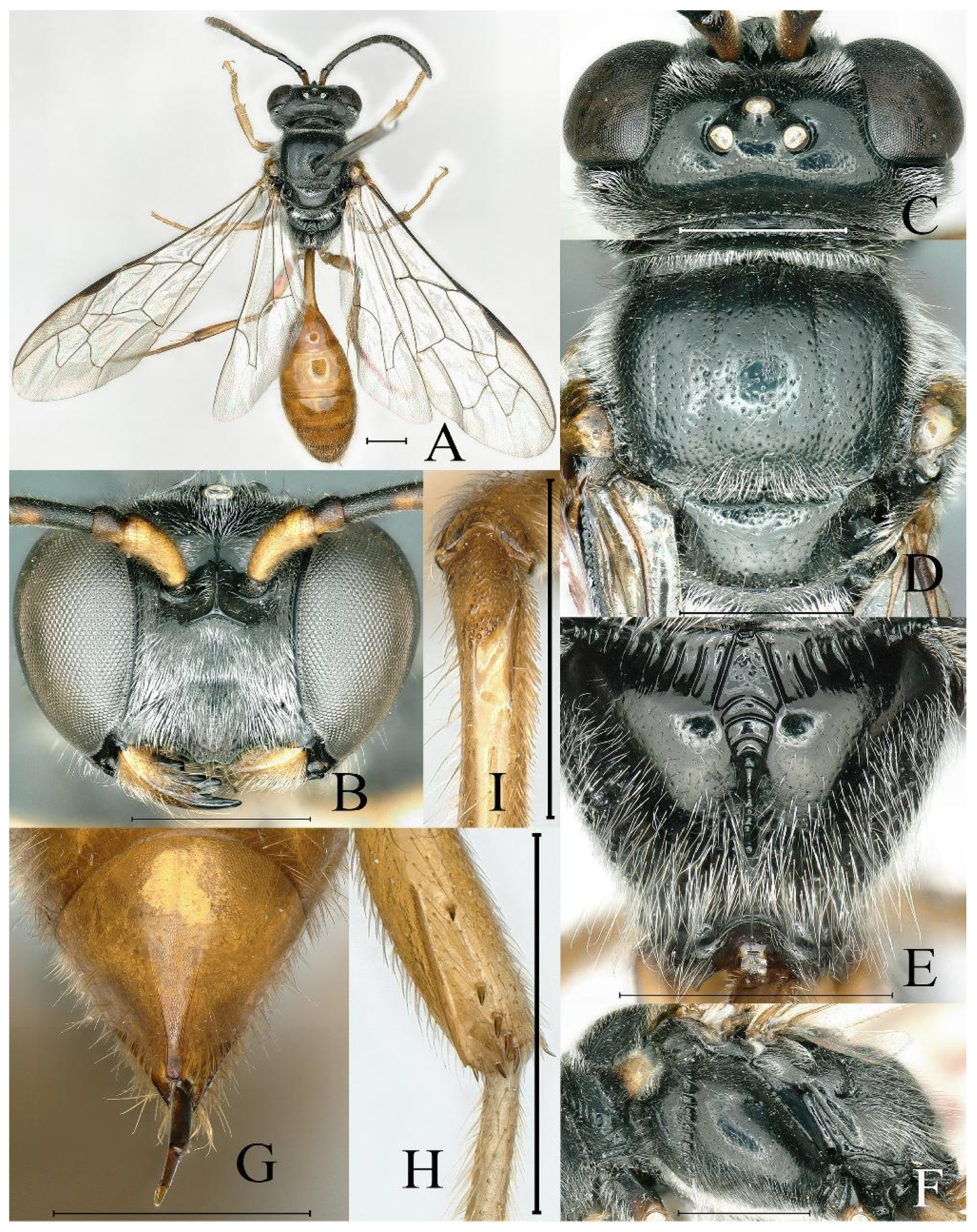
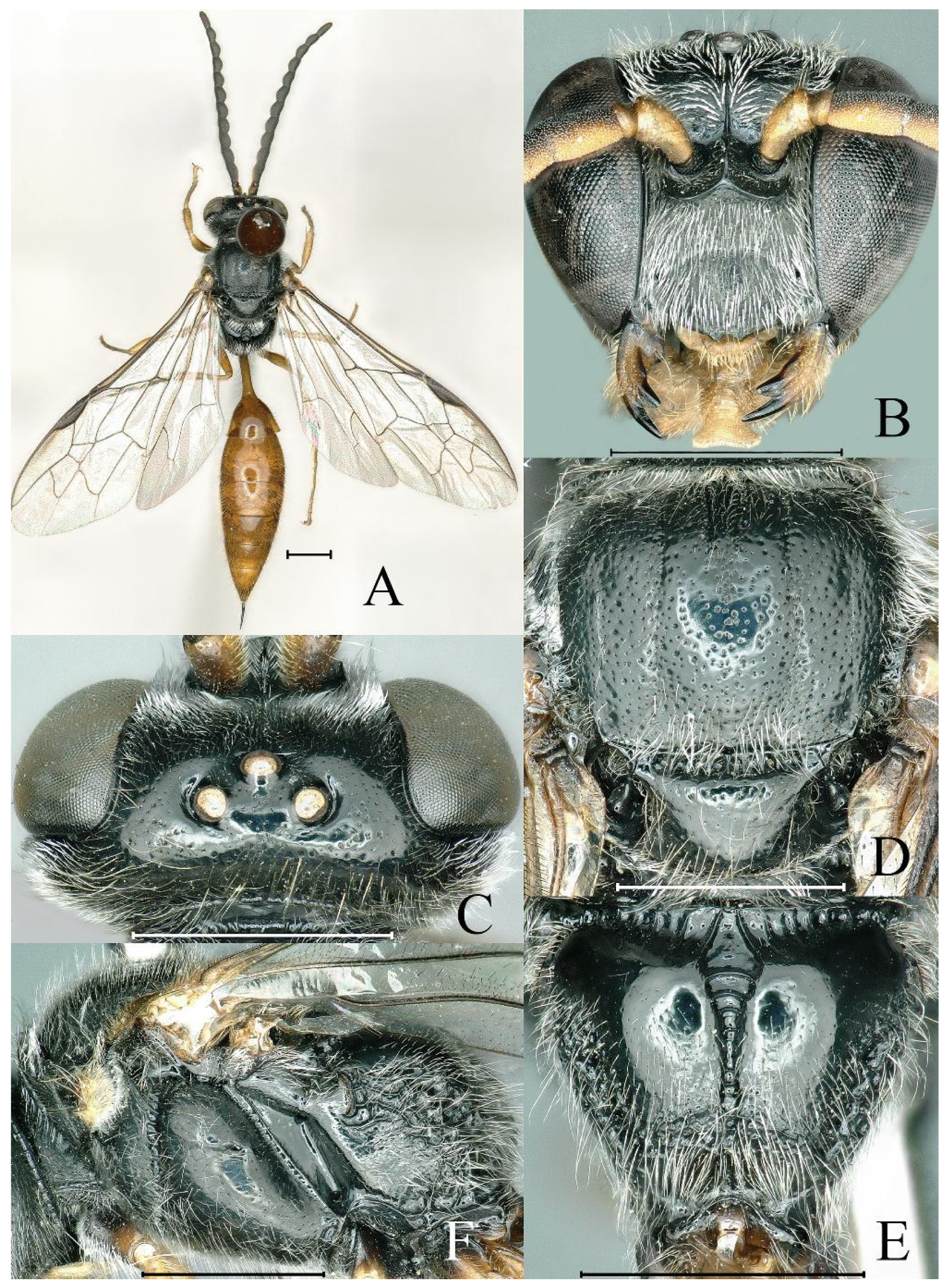
3.2.2. Psenulus clypeoconvexus Jiang & Ma, sp. nov. (Figure 3 and Figure 4)
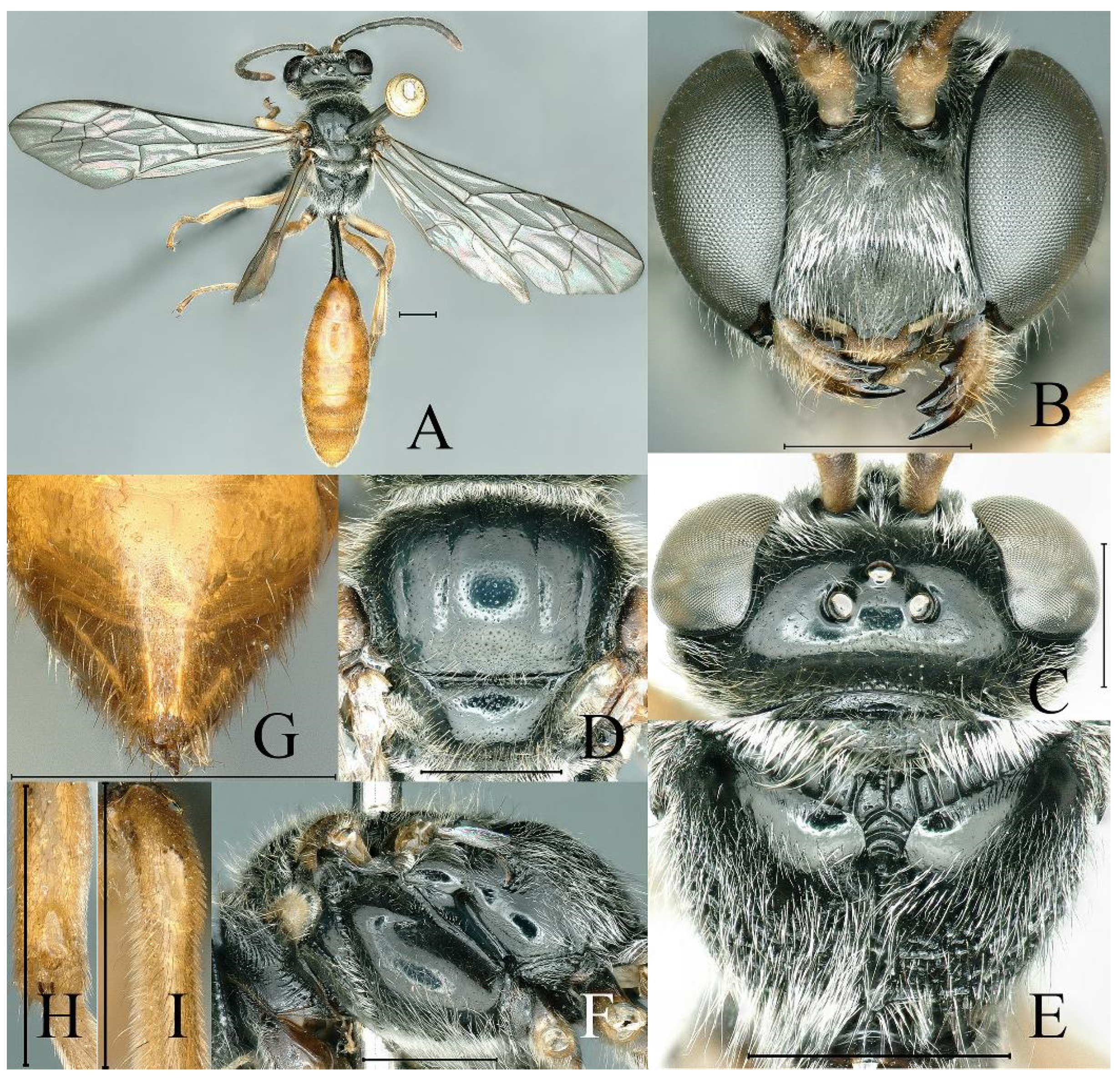
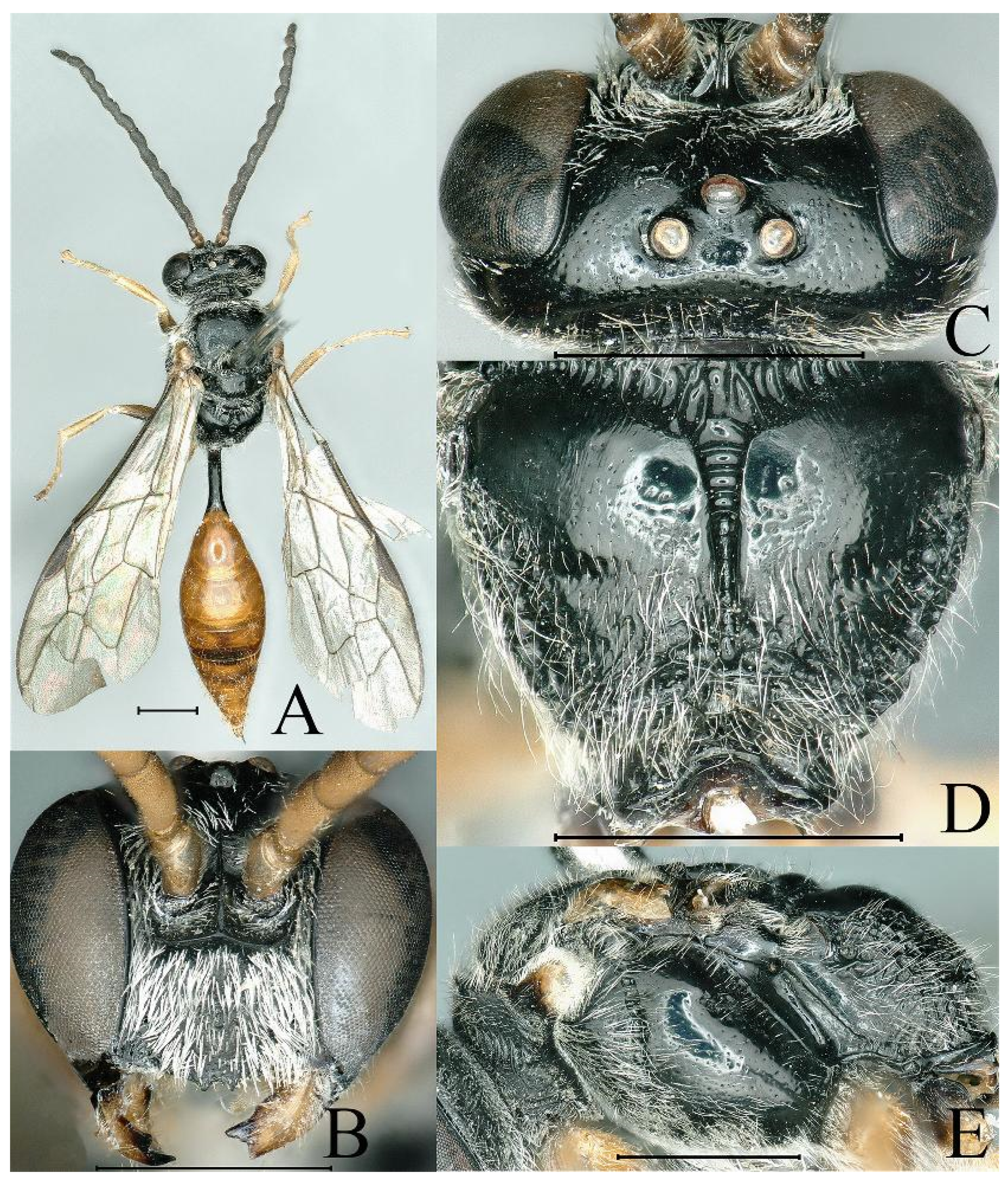
3.3. Newly Recorded Species from China
3.3.1. Psenulus bicinctus Turner, 1912 (Figure 5 and Figure 6)

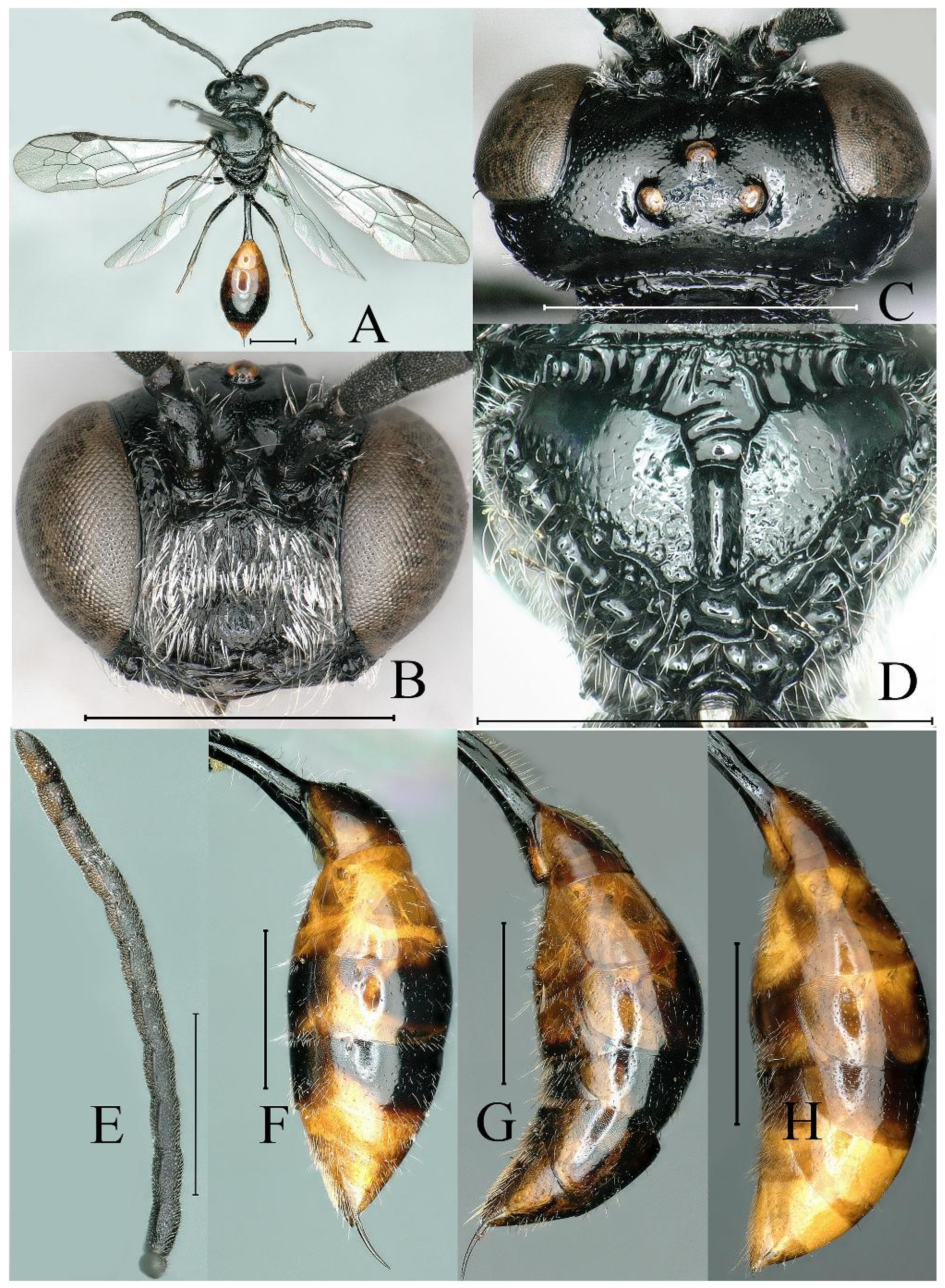
3.3.2. Psenulus orinus van Lith, 1973 (Figure 7 and Figure 8)
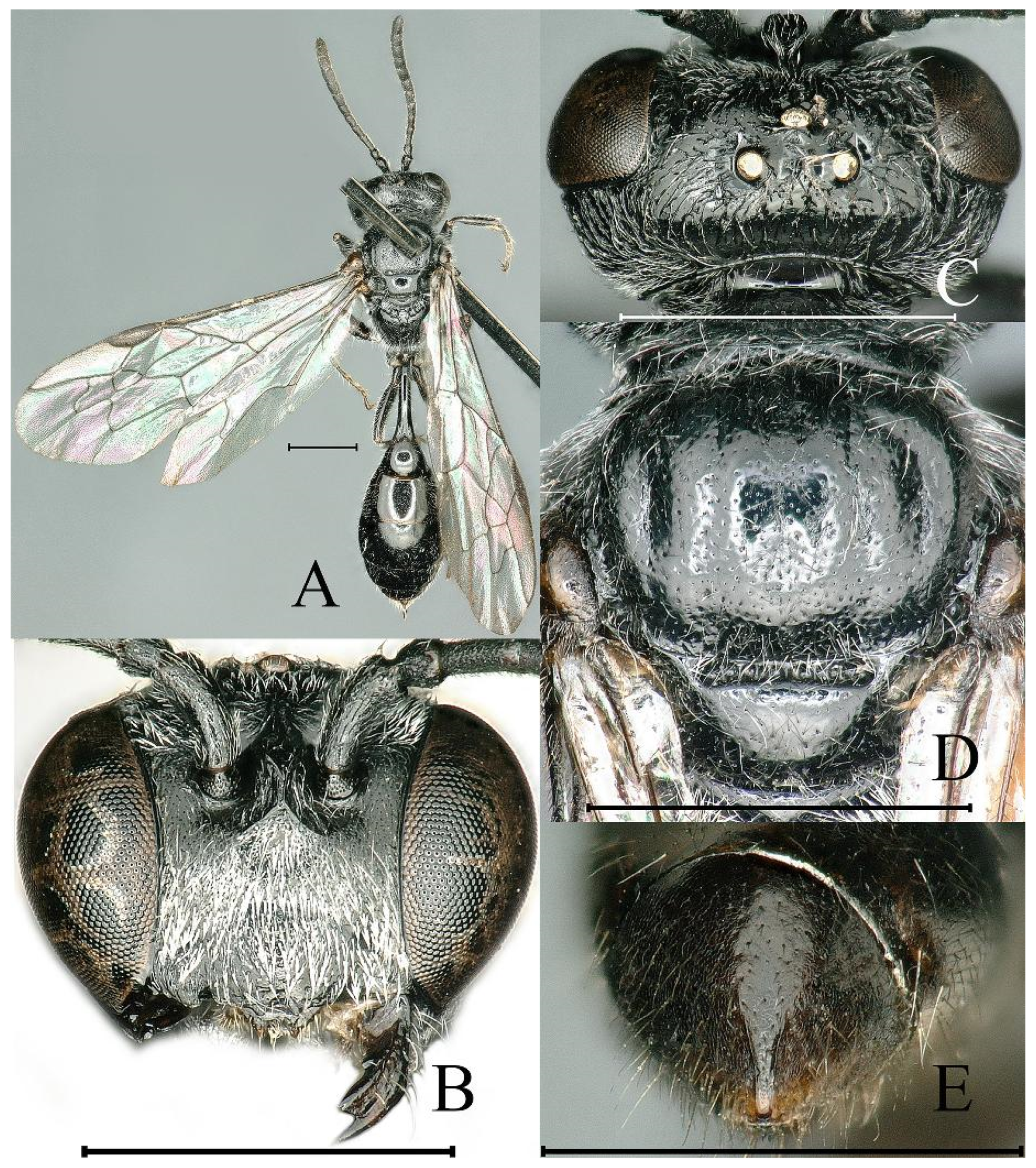
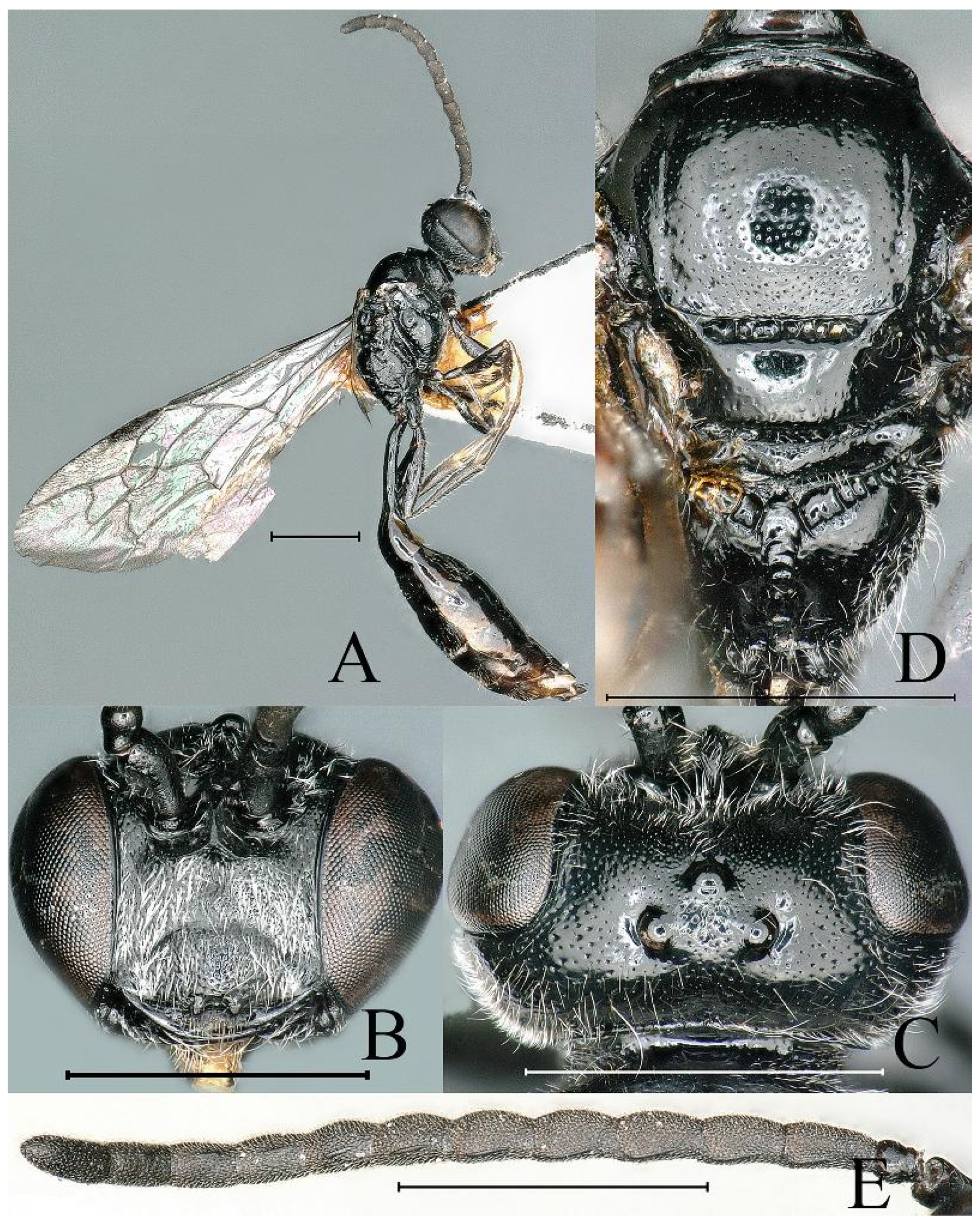
4. Discussion
Author Contributions
Funding
Data Availability Statement
Acknowledgments
Conflicts of Interest
References
- Kohl, F.F. Die Gattungen der Sphegiden. Ann. Des. k.k. Naturhistorischen Hofmuseums 1897, 11, 233–516. [Google Scholar] [CrossRef]
- Ashmead, W.H. Classification of the entomophilous wasps, or the superfamily Sphegoidea. Can. Entomol. 1899, 31, 145–155, 161–174, 212–225, 238–251, 291–300, 322–330, 345–357, 161–174. [Google Scholar] [CrossRef]
- Pulawski, W.J. Catalog of Sphecidae: Psenulus. 70p. 2025. Available online: https://researcharchive.calacademy.org/research/entomology/entomology_resources/hymenoptera/sphecidae/genera/Psenulus.pdf (accessed on 1 February 2025).
- Bohart, R.M.; Menke, A.S. Sphecid Wasps of the World: A Generic Revision; University of California Press: Berkeley, CA, USA; Los Angeles, CA, USA; London, UK, 1976; pp. 1–695. [Google Scholar]
- Hua, L.Z. List of Chinese insects, Vol. IV. Superfamily Apoidea: Sphecoidea; Sun-Yat-sen University Press: Guangzhou, China, 2006; pp. 274–299. [Google Scholar]
- Ma, L.; Li, Q.; Wang, C.H.; Jiang, X.; Lu, H.X. X. Sphecoidea. In Insect Fauna of the Qinling Mountains Hymenoptera; Chen, X., Ed.; World Book Publishing House Xi’an Co., Ltd.: Xi’an, China, 2018; pp. 823–861. [Google Scholar]
- Taylor, C.K.; Barthélémy, C.; Chi, R.C.S.; Guénard, B. Review of Psenulus species (Hymenoptera, Psenidae) in the Hong Kong SAR, with description of three new species. J. Hymenopt. Res. 2020, 79, 169–211. [Google Scholar] [CrossRef]
- Rosa, B.B.; Melo, G.A.R. Systematics of the Neotropical species of the crabronid wasp genus Psenulus. Austral. Entomol. 2020, 59, 422–454. [Google Scholar] [CrossRef]
- Maneval, H. Notes recueillis sur les Hyménoptères. Ann. De La Société Entomol. De France 1932, 101, 85–110. [Google Scholar] [CrossRef]
- Iwata, K. Habits of some Japanese pemphredonids and crabronids (Hymenoptera). Mushi 1938, 1, 20–41. [Google Scholar]
- Melo, G.A.R. Silk glands in adult sphecid wasps (Hymenoptera, Sphecidae, Pemphredoninae). J. Hymenopt. Res. 1997, 6, 1–9. [Google Scholar]
- Serrão, J.E.; Oliveira, C.L.A. Notes on the structure of silk glands in sphecid wasps, Microstigmus and Psenulus (Hymenoptera, Sphecidae, Pemphredoninae). Neth. J. Zool. 2000, 50, 479–486. [Google Scholar] [CrossRef]
- van Lith, J.P. Contribution to the knowledge of the Indo-Australian Pseninae (Hymenoptera. Sphecidae). Part II. Genus Psenulus Kohl, 1896. Zool. Verh. 1962, 52, 1–118. [Google Scholar]
- Viereck, H.L. New species of the subfamily Pseninae. Trans. Am. Entomol. Soc. 1901, 27, 338–342. [Google Scholar]
- Schulz, W.A. Zweihundert alte Hymenopteren. Zool. Ann. 1911, 4, 1–220. [Google Scholar]
- Gussakovskij, V.V. Beitrag zur Kenntnis der Pseninen-und Pemphredoninen-Fauna Japans (Hymenoptera, Sphecidae). Mushi 1934, 7, 79–89. [Google Scholar]
- Turner, R.E. Notes on fossorial Hymenoptera. X. On new species from the Oriental and Ethiopian Regions. Ann. Mag. Nat. Hist. 1912, 10, 361–377. [Google Scholar] [CrossRef]
- van Lith, J.P. Contribution to the knowledge of Oriental Psenulus (Hymenoptera, Sphecidae, Psenini). Tijdschr. Voor Entomol. 1972, 115, 153–203. [Google Scholar]
- van Lith, J.P. New species and records of Indo-Australian Psenini (Hymenoptera, Sphecidae, Pemphredoninae). Tijdschr. Voor Entomol. 1976, 119, 79–122. [Google Scholar]
- Cameron, P. Descriptions of new species of aculeate and parasitic Hymenoptera from Northern India. Ann. Mag. Nat. Hist. 1904, 13, 211–233. [Google Scholar] [CrossRef]
- van Lith, J.P. Contribution to the knowledge of the Indo-Australian Psenini (Hymenoptera, Sphecidae). Part III. New species of the subgenera Psen Latreille and Mimumesa Malloch and a review of East-Asiatic and Indo-Australian Psen Latreille, s.l. Zool. Verh. 1965, 73, 3–80. [Google Scholar]
- van Lith, J.P. Psenini from Nepal (Hymenoptera, Sphecidae). Tijdschr. Voor Entomol. 1973, 116, 123–143. [Google Scholar]
| P. carinitibialis Jiang & Ma, sp. nov. | P. pendleburyi van Lith, 1962 |
|---|---|
| Transverse carina below antennae absent. |
| Propodeal enclosure incomplete, with depressions only along lateral margins. |
| Median longitudinal groove reaching mid-length of propodeum. |
| Mid tibia apex with longitudinal depression. |
| Hind tibia usual, without groove and carina. |
| Pygidial plate elongate-triangular, lateral carinae parallel apically, extending for approximately 1/2 of pygidial plate length. |
| P. clypeoconvexus Jiang & Ma, sp. nov. | P. carinitibialis Jiang & Ma, sp. nov. |
|---|---|
| Petiole reddish yellow (♀♂). |
| Occipital carina not reaching hypostomal carina (♀♂). |
| Propodeal enclosure distinctly broad, not defined posteriorly (♀♂). |
| Transverse carina below antennae distinctly sharp (♀) |
| Interantennal carina relatively narrow dorsally and deeply concave (♀). |
| Mid tibia with longitudinal carina, one row of spines, and without apical depression (♀). |
| Hind tibia with deep groove basally (♀). |
| Pygidial plate with blunt lateral carinae (♀). |
| Depressed margin of clypeus with triangular emargination (♂). |
| Propodeum behind enclosure smooth and shiny, without rugae (♂). |
Disclaimer/Publisher’s Note: The statements, opinions and data contained in all publications are solely those of the individual author(s) and contributor(s) and not of MDPI and/or the editor(s). MDPI and/or the editor(s) disclaim responsibility for any injury to people or property resulting from any ideas, methods, instructions or products referred to in the content. |
© 2025 by the authors. Licensee MDPI, Basel, Switzerland. This article is an open access article distributed under the terms and conditions of the Creative Commons Attribution (CC BY) license (https://creativecommons.org/licenses/by/4.0/).
Share and Cite
Jiang, H.; Li, Q.; Ma, L. The Genus Psenulus Kohl, 1897 (Hymenoptera: Crabronidae) in China, with Two New Species and Two New Country Records. Insects 2025, 16, 432. https://doi.org/10.3390/insects16040432
Jiang H, Li Q, Ma L. The Genus Psenulus Kohl, 1897 (Hymenoptera: Crabronidae) in China, with Two New Species and Two New Country Records. Insects. 2025; 16(4):432. https://doi.org/10.3390/insects16040432
Chicago/Turabian StyleJiang, Huifen, Qiang Li, and Li Ma. 2025. "The Genus Psenulus Kohl, 1897 (Hymenoptera: Crabronidae) in China, with Two New Species and Two New Country Records" Insects 16, no. 4: 432. https://doi.org/10.3390/insects16040432
APA StyleJiang, H., Li, Q., & Ma, L. (2025). The Genus Psenulus Kohl, 1897 (Hymenoptera: Crabronidae) in China, with Two New Species and Two New Country Records. Insects, 16(4), 432. https://doi.org/10.3390/insects16040432






